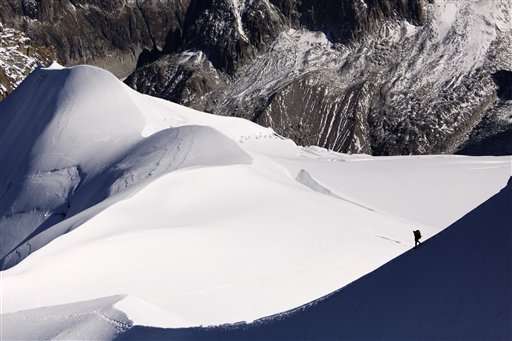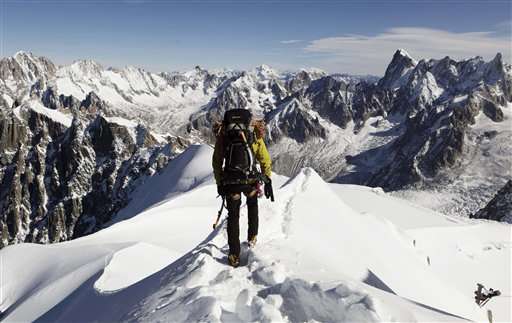Skiing, climbing, global warming: French Alps show dilemma

The Alps are the birthplace of downhill skiing and a crucible for mountain climbing—but now the French government is trying to help their winter tourist towns adapt to a warming world.
French Prime Minister Manuel Valls visited the Mer de Glace (the Sea of Ice) Friday on Mont Blanc, where the retreating glacier has been documented for more than a century, through water colors painted before the invention of the still camera, black-and-white photos depicting a then-modern steam locomotive chuffing alongside the ice and today's high-definition satellite photos.
"The Mer de Glace reveals the extent of climate change, and, to the naked eye," said Valls. "The time has come to mobilize."
Researchers say the Sea of Ice is only the most accessible example of a problem the entire Alpine region is facing as warming mountainsides become more unstable and snowfall more inconsistent, threatening jobs and lives in a region heavily dependent on adventure tourism.
Scientists have drilled the Mont Blanc region with sensor-equipped boreholes in recent years, hoping that measuring temperatures in the permafrost will give a sense of how quickly the problem is accelerating and which areas are most in peril.
The town of Lanslevillard already knows firsthand, said Xavier Bodin, a researcher for France's elite CNRS research center who specializes in Alpine permafrost. A debris flow touched off by an unstable rock glacier swept down the slope, crushing snow equipment.

In another part of the southeast French region, pylons for a ski lift had to be re-planted because the foundation grounds were melting. Elsewhere, retreating glaciers have exposed climbers to new, untested and potentially risky routes, he said.
"The rising temperatures in the mountains strongly modify the way people approach the high altitudes," Bodin said.
In a study released this year in the Journal of Alpine Research, researchers documented 350 rock falls from 2007 to 2014 compared with almost none from 1855 to 1936. They found that of 1,769 pieces of infrastructure—including huts, ski lifts and pipelines—about 10 percent were at high risk of rock fall damage, including Mont Blanc's popular Aiguille du Midi cable car.
Valls is visiting the region to highlight France's role as host in the global summit on climate change at the end of this year.
© 2015 The Associated Press. All rights reserved.


















